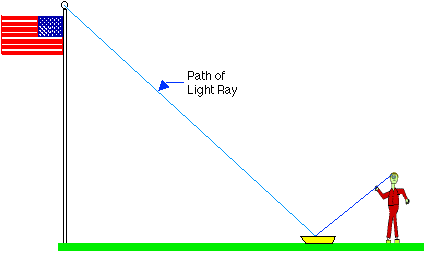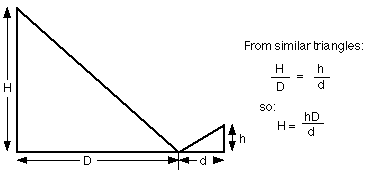Physics Activity
Using the Law of Reflection to Measure Heights



![[Help]](../../../NavIcons/Help.GIF)
Purpose:
To measure the height of a tall object (tree, light pole, flag
pole) using the Law of Reflection.
Discussion:
It is very easy to use the Law of Reflection and some simple
geometry to measure the height of an object that would be very
difficult to measure directly. Please study the diagram below.
In this diagram ab a person observes the image of the top of a
flagpole, using the surface of a bowl of water as the reflecting
surface. The Law of Reflection guarantees that the two triangles
formed are similar (Do you see why?)

In the diagram below, "h" is the height of the person's eyes above
the surface of the water, and "d" is the horizontal distance from the
person to the center of the bowl. "H" represents the height of the
flagpole, and "D" is the horizontal distance from the flagpole to the
bowl of water. The 3 distances h, d, and D are easy to measure.

Equipment:
|
small bowl
|
meter stick
|
water
|
|
small mirror
|
dark colored paper
|
|
Procedure:
- Pick a tall object (perhaps your teacher has a suggestion), a
flag pole or utility pole, for instance.
- Put some water in a small bowl, and place the bowl on the
ground a few meters from the tall object.
- Move around until you can see the image of the top of the pole
reflected in the water's surface. If you have trouble seeing the
reflected image, it may help to put some dark colored paper in the
bottom of the bowl. (If a breeze is blowing the water's surface
too much to form a clear image, you can carefully float a small
mirror on the surface of the water and use the mirror for your
reflecting surface.)
- Measure the distance from the bowl to your feet (d) , the
distance from the bowl to the base of the light pole (D), and
record them in your data table (A sample data table is shown
below).
- Measure the vertical distance from the bowl to your eye (h).
- Move the bowl to another distance from the pole, and repeat
your measurements until you are satisfied that you have enough
data.

Results:
- Use similar triangles (as shown above) to calculate the height
of your tall object for each trial. Show a sample calculation, and
record your results in your data table.
- Calculate the average height of your measurements.
Conclusions:
How closely do your height measurements agree? Do you think that
this is an accurate way to measure heights? Why? What factors most
affect the accuracy of this method?
What is the advantage of using water as a reflecting surface for
this activity, instead of just laying a mirror on the ground?
reference:
IHETS AP Physics Lab #2 - September 1992



![[Help]](../../../NavIcons/Help.GIF) ../../../Help.html
../../../Help.html
last update August 14, 1997 by JL Stanbrough